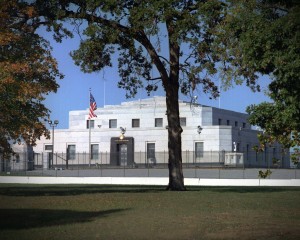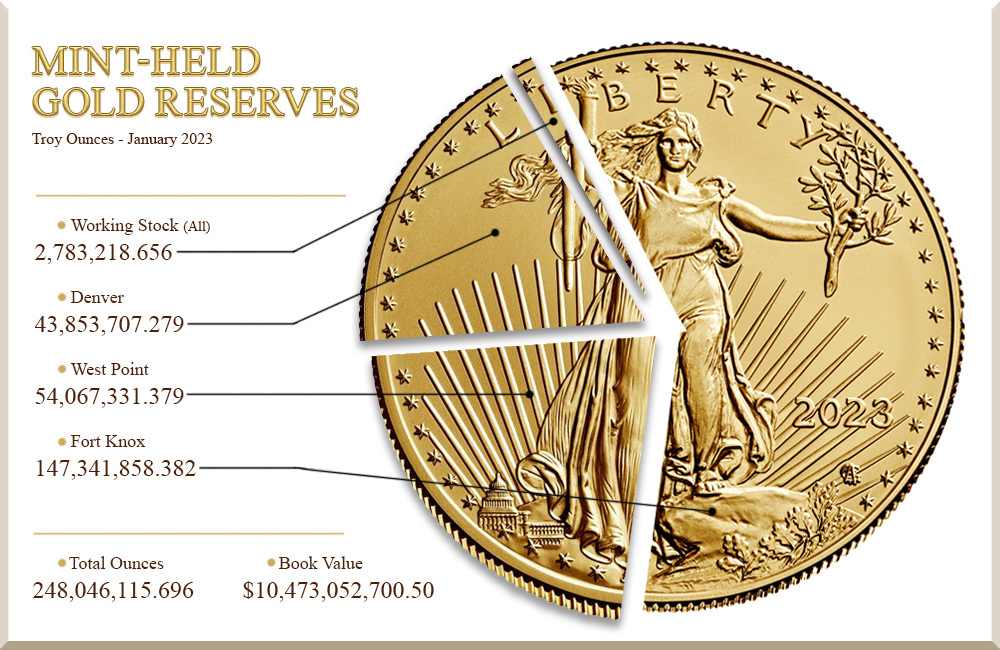 The United States Bullion Depository at Fort Knox, Kentucky is not a production facility – it stores precious metal bullion reserves for the United States.
The United States Bullion Depository at Fort Knox, Kentucky is not a production facility – it stores precious metal bullion reserves for the United States.
No visitors are permitted in the facility.
Fort Knox Facts
- Amount of present gold holdings: 147.3 million ounces. About half of the Treasury’s stored gold (as well as valuables of other federal agencies) is kept at Fort Knox.
- Highest historic gold holdings: 649.6 million ounces (December 31, 1941).
- The only gold removed has been very small quantities used to test the purity of gold during regularly scheduled audits. Except for these samples, no gold has been transferred to or from the Depository for many years.
- The gold is held as an asset of the United States at book value of $42.22 per ounce.
- Size of a standard gold bar: 7 inches x 3 and 5/8 inches x 1 and 3/4 inches.
- Weight of a standard gold bar: approximately 400 ounces or 27.5 pounds.
- The actual structure and content of the facility is known by only a few, and no one person knows all the procedures to open the vault.
- The first gold arrived at Fort Knox in 1937…by U.S. Mail! View photos of the shipment on the History of the U.S. Mint page.

History of the Fort Knox Bullion Depository
The timeline below includes this facility’s important moments. Learn more about where the Fort Knox Bullion Depository fits in the Mint’s story, at History of the U.S. Mint.
1935 - Present
August - Congress authorizes the transfer of land in Fort Knox, Kentucky from the military to the Treasury. The Act designates the land for use as a depository to store the country's precious metal bullion reserves.
December - Construction of the bullion depository is complete.
The building needs 16,000 cubic feet of granite; 4,200 cubic yards of concrete; 750 tons of reinforcing steel; and 670 tons of structural steel. The cost of construction is $560,000.
January 13 - Fort Knox receives its first shipment of gold from the Philadelphia Mint and New York Assay Office.
Fort Knox stores the Declaration of Independence, Constitution, and Bill of Rights during World War II to protect them from danger. In 1944 the documents are returned to Washington, DC.
Fort Knox has stored valuable items for other government agencies, including the Magna Carta, and the crown, sword, scepter, orb, and cape of St. Stephen, King of Hungary before being returned to Hungary in 1978.
September 23 - Fort Knox breaks from its strict no-visitors policy to allow a group of journalists and a Congressional delegation into the vaults to view the gold reserves. The Treasury Secretary allows the visit when rumors persist that all the gold had been removed from the vaults.
Previously, President Franklin D. Roosevelt was the only person other than authorized personnel to access the vaults.
August 24 - Treasury Secretary Steve Mnuchin, Kentucky Governor Matt Bevin, and Congressional representatives visit the vaults. The vaults open to non-authorized personnel for the first time since 1974.
Other Mint Facilities: Denver | Philadelphia | San Francisco | Washington, DC | West Point


